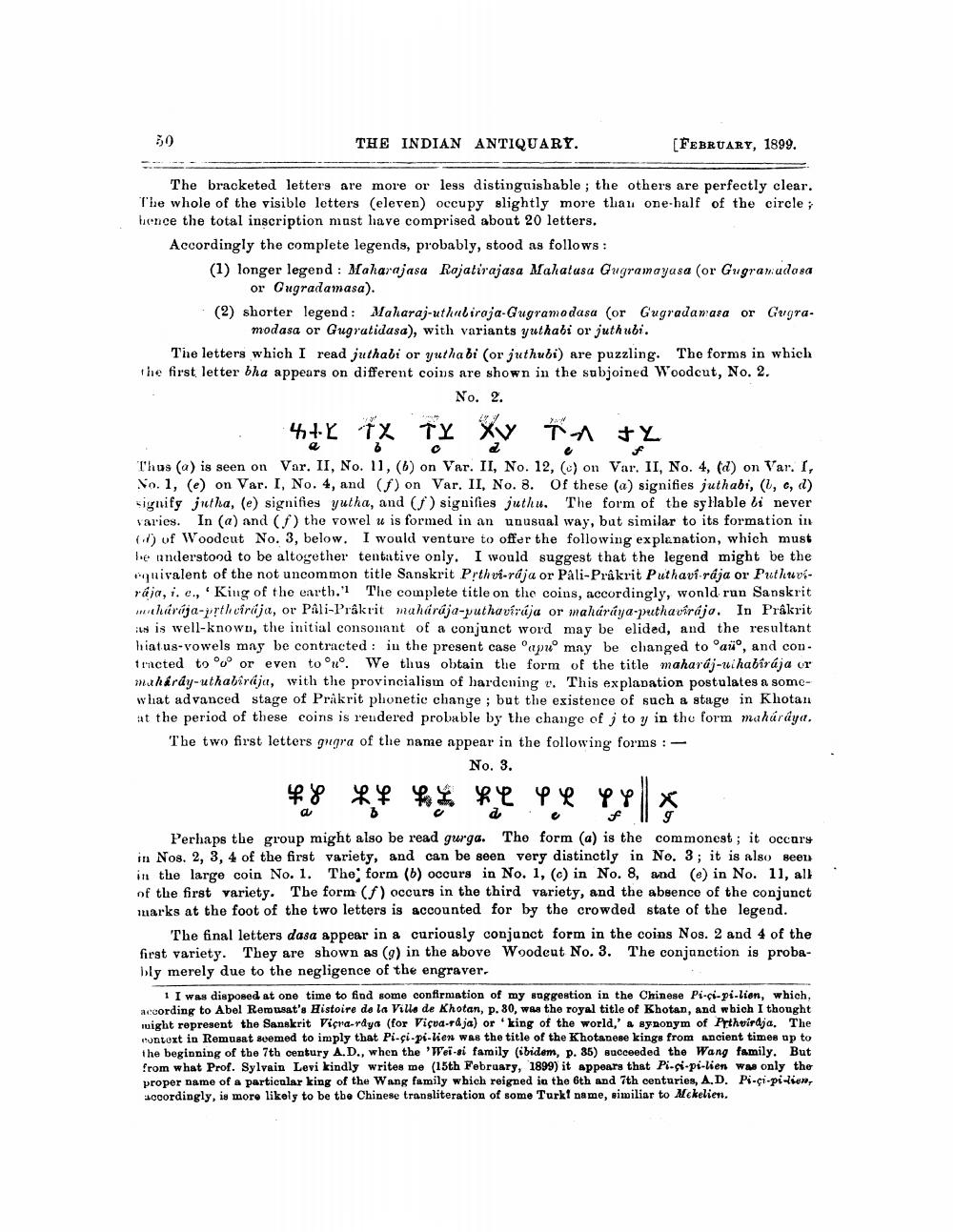________________
30
THE INDIAN ANTIQUARY.
[FEBRUARY, 1899.
The bracketed letters are more or less distinguishable; the others are perfectly clear. The whole of the visible letters (eleven) occupy slightly more than one-half of the circle ; bence the total inscription must have comprised about 20 letters. Accordingly the complete legends, probably, stood as follows: (1) longer legend : Maharajasa Rojatirajasa Mahalasa Gugramayasa (or Gugranudosa
or Cugradamasa). (2) shorter legend: Maharaj-uthabiraja-Gugramadasa (or Gugradamasa or Gugra
modasa or Gugratidasa), with variants yuthabi or juthubi. The letters which I read juthabi or yuthabi (or juthubi) are puzzling. The forms in which the first letter bha appears on different coins are shown in the subjoined Woodcut, No. 2.
No. 2.
414.2 TX TY Xv
T 1
+ x
Thus (a) is seen on Var. II, No. 11, (6) on Var. II, No. 12, (c) on Var. II, No. 4, (d) on Var. I, No.1, (e) on Var. I, No. 4, and (f) on Var. II, No. 8. Of these (a) signifies juthabi, (1, C, d) Signify jutha, (e) signifies yutha, and () siguifies juthu. The form of the syllable li never
aries. In (a) and (f) the vowel u is formed in an unusual way, but similar to its formation in (1) of Woodcut No. 3, below. I would venture to offer the following explanation, which must he understood to be altogether tentative only. I would suggest that the legend might be the equivalent of the not uncommon title Sanskrit Pyth vi-rája or Pali-Prakrit Puthavírája or Puthuvirája, i. c., 'King of the earth. The complete title on the coins, accordingly, wonld run Sanskrit w horúja-prthvirája, or Pali-Prakrit mahárúja-puthavírája or maháráya-puthavírája. In Prakrit its is well-known, the initial consonant of a conjunct word may be elided, and the resultant hiatus-vowels may be contracted in the present case 'apu" may be changed to aüo, and contracted to °° or even to oro. We thus obtain the form of the title maharaj-uihabírája or muhárdy-uthabírája, with the provincialism of hardening v. This explanation postulates a somewhat advanced stage of Prakrit phonetic change; but the existence of such a stage in Khotan at the period of these coins is rendered probable by the change of ; to y in the form mahárdya. The two first letters gugra of the name appear in the following forms :
No. 3.
48 hf he ke ye yol
a Do do 'f|| Perhaps the group might also be read gurga. The form (a) is the commonest; it occurs in Nos. 2, 3, 4 of the first variety, and can be seen very distinctly in No. 3; it is also seen in the large coin No. 1. The form (6) occurs in No. 1, (c) in No. 8, and (€) in No. 11, all of the first variety. The form (f ) occurs in the third variety, and the absence of the conjunct marks at the foot of the two letters is accounted for by the crowded state of the legend.
The final letters dasa appear in a curiously conjunct form in the coins Nos. 2 and 4 of the first variety. They are shown as (9) in the above Woodent No. 3. The conjunction is probably merely due to the negligence of the engraver.
1 I was disposed at one time to find some confirmation of my suggestion in the Chinese Pi-ci-pi-lion, which, according to Abel Remusat's Histoire de la Villa de Khotan, p. 80, was the royal title of Khotan, and which I thought luight represent the Sanskrit Vicra-raya (for Viçua-raja) or 'king of the world,' synonym of Pythvirdja. The context in Remusat semed to imply that Pi-çi-pi-lien was the title of the Khotanese kings from ancient times up to the beginning of the 7th century A.D., when the 'Wei-si family (ibidem, p. 35) succeeded the Wang family. But from what Prof. Sylvain Levi kindly writes me (15th February, 1899) it appears that Pi.ci-pi-lien was only the proper name of a particular king of the Wang family which reigned in the 6th and 7th centuries, A.D. Pi.ci-pi-lion, Accordingly, is more likely to be the Chinese transliteration of some Turki name, similiar to Mckelien.




